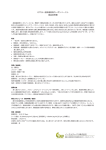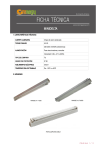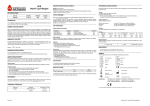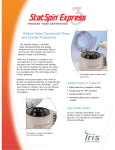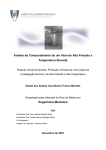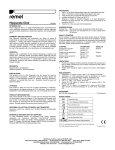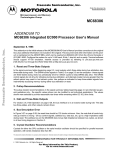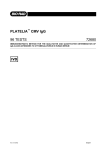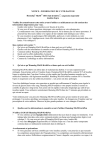Download ACE kinetic
Transcript
ACE kinetic Angiotensin Converting Enzyme KK-ACK KK-ACK2 KK-ACKX BÜHLMANN LABORATORIES AG Baselstrasse 55 CH - 4124 Schönenbuch, Switzerland Tel.: +41 61 487 1212 Fax: +41 61 487 1234 [email protected] 100 tests 2 x 50 tests 1200 tests English Deutsch Français Italiano Español page 2 Seite 3 page 5 pagina 7 página 8 ENGLISH INTENDED USE The BÜHLMANN ACE kinetic test is intended for the direct and quantitative in vitro diagnostic determination of angiotensin converting enzyme (ACE) activity in serum by an enzymatic assay. PRINCIPLE OF THE ASSAY ACE catalyses the conversion of angiotensin I to angiotensin II. The enzyme also mediates the cleavage of a synthetic substrate (FAPGG) into an amino acid derivative and a dipeptide. The kinetics of this cleavage reaction are measured by following the decrease in absorbance at 340 nm (1,2). The ACE kinetic method is standardized with the BÜHLMANN ACE colorimetric kit (order code: KK-ACE) according to the method described in references 3 and 4 dole. REAGENTS SUPPLIED AND PREPARATION Reagents Quantity KK-ACK KK-ACK2 Code KK-ACKX Reconstitution Substrate 1 vial 26 ml 2 vials 13 ml 3 vials 100 ml B-ACK-SUB B-ACK2-SUB1 B-ACKX-SUB2 Ready to use Calibrator3 1 vial 2 vials 3 vials B-ACK-CA add 2 ml of sterile water 2 vials 2x2 vials 3x2 vials B-ACK-CONSET add 2 ml of sterile water 4 Controls Normal and High 1 2 3 4 Order Codes for KK-ACK2. Table 1 Order Codes for KK-ACKX. Lyophilized ACE Calibrator in a protein serum matrix with lot specific activity. After reconstitution leave for 15 minutes at 18-28°C and mix well before use. The Calibrator has been standardized with the BÜHLMANN ACE colorimetric kit (cf. above). Lyophilized ACE Normal and High Controls in a protein serum matrix with lot specific activity. After reconstitution leave for 15 minutes at 1828°C and mix well before use. STORAGE AND SHELF LIFE OF REAGENTS Unopened Reagents Stable at 2-8°C until expiration date printed on the label Opened / Reconstituted Reagents Substrate Calibrator ACE Controls Stable until exp. date at 2-8°C Stable for 6 months at 2-8°C Table 2 WARNINGS AND PRECAUTIONS All reagents of this kit contain components of human origin. Each serum donor unit used in the preparation of the kit components was tested by an FDA approved method and found negative for HBV surface antigen, so as for HCV and HIV1/2 antibodies. Although these methods are highly accurate, there is no guarantee that this material cannot transmit Hepatitis or AIDS. Therefore, all patient specimens and kit components should be handled as if capable of transmitting infections. All products containing human source Revision date: 2003-02-21 2/18 material should be handled in accordance with good laboratory practice using appropriate precautions. Calibrator and ACE Controls contain sodium azide as a preservative in a concentration less than 0.01 mg/ml MATERIALS REQUIRED BUT NOT PROVIDED • • Precision pipettes: 25, 100, 150, 250 μl and 2 ml Plastic test tubes for sample or calibrator incubation • Vortex mixer • Waterbath for incubation set at 37°C • Spectrophotometer with temperature controlled cuvette holders for incubation at 37°C and for measurement of absorbance at 340 nm • Clinical chemistry analyzer with 340 nm filter (optional) SPECIMEN COLLECTION AND STORAGE Since EDTA inhibits ACE activity, serum specimen should be used for the determination of ACE activity: • Collect sufficient blood (at least 0.5 ml) by venipuncture into an appropriate tube without anticoagulant. • Let the blood stand for 2-3 hours at room temperature, then centrifuge at 4°C and 1000 x g; collect the serum. • Freeze the serum specimen at –20°C if not assayed within 5 days. ACE activity in sterile serum is stable for up to 30 days at 2-8°C and 6 months at –20°C. To avoid lipemic sera, the blood sample should be taken from fasting patient. Due to interference with the photometric determination lipemic sera must be pretreated either with an Ultracentrifuge or with LipoClear from StatSpin Inc. (www.statspin.com). Icteric or hemolytic sera can not be used for the ACE activity determination. ASSAY PROCEDURE Assay Protocol (For automatic procedure cf. next chapter below) Allow the substrate to come to room temperature. Avoid heating of the substrate. Pretreat all lipemic sera according to the procedure as described above. 1. Label two plastic tubes for each calibrator and control serum. Label additional tubes for each patient sample. 2. Pipet 25 μl of Calibrator, Control serum and patient Sample, respectively, into the corresponding tubes. NOTE:For each sample follow individually the procedure outlined below (according to the capacity of the photometer used): 3. Add 250 μl of substrate to each sample and vortex thoroughly. 4. Incubate for 5 minutes at 37°C in a water bath. 5. Set your photometer to zero absorbance with distilled water. 6. Transfer sample into a microcuvette and measure absorbance at 37°C and 340 nm twice in a time interval of exactly 10 minutes. BÜHLMANN ACE kinetic RESULTS AND AUTOMATION Standardization The values of this assay are identical to the values obtained with the standard BÜHLMANN ACE colorimetric assay kit (order code: KK-ACE). This standardization has the advantage that results obtained with either the colorimetric method or the radioenzymatic method are intercomparable. Automation with Chemistry Analyzers ACE kinetic can be performed on every open chemistry analyzer. For instructions on programming and operation please refer to the “Operators Manual” of the Instrument. NOTE:Each laboratory should establish its own instrument settings for the individual requirements. PARAMETER LISTINGS FOR SEVERAL CHEMICAL ANALYZERS ARE AVAILABLE UPON REQUEST. CALCULATION Calculate the corresponding enzyme activity (Ex) of each unknown sample by dividing the difference in absorbance of the individual sample (ΔAx) through the mean of the absorbance difference of the calibrator vial (ΔAc) and multiply by the enzyme activity (Ec) indicated on the data sheet (for an example see Table 11): Ex = ΔAx × Ec ΔAc Definition: One unit of ACE activity is defined as the amount of enzyme required to release one μmol of Hippuric Acid per minute and per liter of serum at 37°C as determined by the colorimetric assay: 1 ACE unit = 1μmol hippuric acid min× L QUALITY CONTROL The values of the Normal and High Controls provided with the kit must be within the lot specific range indicated on the corresponding data sheet. If not, the assay has to be repeated. It is good laboratory practice to record the following data for each assay: kit lot number, reconstitution dates of kit components used, concentration value of calibrator and of controls, concentration values of internal serum pool. Spiking Recovery: 99.8%. Two different serum samples have been spiked with increasing amounts of ACE and analyzed according to the assay procedure (cf. Table 15). Specificity: Inhibition by its natural substrate Ang I and by EDTA and H-Val-Trp-OH. A serum sample of defined ACE activity has been inhibited and measured again (cf. Table 16). Linearity: The kinetic method is linear from 12 to 150 ACE units. EXPECTED VALUES From a group of 93 adult (age 20-70 years) blood donors from Switzerland, the normal serum range (Mean + 2SD) has been determined to be: 12 – 68 ACE units Serum samples from 50 sarcoidosis patients were within a range of 45-135 units (5) Serum ACE levels in individuals under 18 years of age are substantially higher and more variable than in adults. Those should be established separately (6). METHOD COMPARISON The comparison of 66 sera from apparently healthy donors (age: 20 – 70 years) were analyzed using the presented ACE kinetic assay as well as the ACE colorimetric and the ACE direct radioenzymatic (REA) kits from BÜHLMANN LABORATORIES AG (order codes: KK-ACE and RK-ACD). The subsequent linear regression analysis yielded the following statistics: ACE kinetic = 1.098 * ACE colorimetric – 7.83 ACE units; r = 0.964; R2 = 0.868 ACE kinetic = 1.449 * ACE direct – 17.22 ACE units; r = 0.938; R2 = 0.880 Means: 42.1 ACE units (ACE kinetic) 45.5 ACE units (ACE colorimetric) 40.9 ACE units (ACE direct) PERFORMANCE CHARACTERISTICS Intra-Assay Precision: 2.7%. The intra-assay precision has been determined by measuring three different serum samples 20 times in a single test run (cf. Table 12). Inter-Assay Precision: 8.1%. The inter-assay precision has been determined by measuring three control serum samples in 20 different runs (cf. Table 13). Sensitivity: The minimum detectable dose of ACE was determined to be 12 ACE units. Dilution Linearity: r = 0.998. Two elevated serum samples have been diluted with physiological NaCl solution (cf. Table 14). Revision date: 2003-02-21 3/18 BÜHLMANN ACE kinetic ČESKY POUŽITÍ Metoda ACE kinetic firmy BÜHLMANN je určena pro přímé a kvantitativní in vitro enzymatické stanovení aktivity ezymu konvertujícího angiotenzin (angiotensin converting enzyme -ACE) v séru enzymatickou metodou. PRINCIP METODY ACE je katalyzátorem konverze angiotenzinu I na angiotenzin II. Enzym také provádí štěpení syntetického substrátu (FAPGG) na derivát aminokyseliny a dipeptid. Kinetiku tohoto štěpení je možné detekovat měřením poklesu absorbance při vlnové délce 340 nm (1,2). Metoda ACE kinetic je standardizována pomocí kolorimetrické soupravy ACE firmy BÜHLMANN (katalogové číslo: KKACE) podle metody, která je popsána v literatuře 3 a 4 dole DODÁVANÉ REAGENCIE A PŘÍPRAVA Reagencie Množství KK-ACK KK-ACK2 KK-ACKX Kat.číslo Rekonstituce Připravený k použití 1 lahvička 26 ml 2 lahvičky 13 ml 3 lahvičky 100 ml B-ACK-SUB B-ACK2-SUB1 B-ACKX-SUB2 Kalibrátor3 1 lahvička 2 lahvičky 3 lahvičky B-ACK-CA přidejte 2 ml sterilní vody Kontroly4 Normální a vysoká hladina 2 lahvičky 2x2 lahvičky 3x2 lahvičky B-ACKCONSET přidejte 2 ml sterilní vody Substrát 1 2 3 4 Katalogové číslo pro KK-ACK2. Tabulka 1 Katalogové číslo pro KK-ACKX. Lyofilizovaný kalibrátor ACE v proteinové sérové matrici s aktivitou specifickou pro šarži. Po rekonstituci nechejte stát 15 minut při teplotě 1828°C a před použitím dobře promíchejte. Kalibrátor byl standardizován pomocí kolorimetrické soupravy ACE colorimetric firmy BÜHLMANN ACE (viz výše). Lyofilizované kontroly ACE s normální a vysokou hladinou v proteinové sérové matrici s aktivitou specifickou pro šarži. Po rekonstituci nechejte stát 15 minut při teplotě 18-28°C a před použitím dobře promíchejte. SKLADOVÁNÍ A TRVANLIVOST REAGENCIÍ Neotevřené reagencie Stabilní při teplotě 2-8°C do expirace uvedené na štítku Otevřené / Rekonstituované reagencie Substrát Kalibrátor Kontroly ACE Stabilní při teplotě 2-8°C do expirace Stabilní 6 měsíců při teplotě 2-8°C Tabulka 2 BEZPEČNOSTNÍ UPOZORNĚNÍ A OPATŘENÍ Všechny reagencie v této soupravě obsahují komponenty lidského séra. Každé použité sérum bylo testováno metodami schválenými FDA na povrchový antigen HBV a na protilátky proti HCV a HIV 1/2 a shledáno negativním. I přes vysokou přesnost těchto metod nelze zaručit, že materiály nemohou přenášet Revision date: 2003-02-21 4/18 hepatitidu nebo AIDS. Z těchto důvodů se se všemi pacientskými vzorky a komponenty soupravy musí nakládat, jako by byly potenciálně infekční. Se všemi výrobky obsahujícími komponenty lidského séra se musí nakládat v souladu s dobrou laboratorní praxí při dodržení příslušných bezpečnostních předpisů. Kalibrátor a kontroly ACE obsahují azid sodný jako konzervační prostředek v koncentraci nižší než 0,01 mg/ml POŽADOVANÝ MATERIÁL A VYBAVENÍ • • Přesné pipety: 25, 100, 150, 250 μl a 2 ml Plastové zkumavky pro inkubaci vzorku nebo kalibrátoru • Dvakrát destilovaná nebo sterilní voda • Míchačka (Vortex) • Vodní lázeň pro inkubaci nastavená na teplotu 37°C • Spektrální fotometr 340 nm, filtrační fotometr 342 nm nebo analyzátor pro klinickou chemii s temperovaným nosičem kyvet (37°C pro inkubaci a měření) ODBĚR A SKLADOVÁNÍ VZORKŮ Přítomnost EDTA při odběru blokuje aktivitu ACE. Proto je nutné provádět stanovení ACE pouze v séru: • Odeberte dostatečné množství krve (nejméně 0,5 ml) venepunkcí do zkumavky bez přípravků zabraňujících srážení. • Nechejte krev stát 2-3 hodiny při pokojové teplotě, poté proveďte centrifugaci při 4°C a 1000 x g; odeberte sérum. • Pokud provedete stanovení do 5 dnů, můžete uchovávat sérum v lednici při 2-8°C (u sterilního séra je možné uchování až 30 dnů při teplotě 2-8°C). Aktivita ACE zůstává v séru uchována až 6 měsíců při teplotě –20°C. Aby se zabránilo lipémii, je nutné odebrat sérum nalačno. Lipemické sérum je nutné ošetřit ultracentrifugací nebo prostředkem LipoClear od firmy StatSpin Inc. (www.statspin.com). Žloutenková nebo hemolyzovaná séra nelze použít. POSTUP STANOVENÍ Příprava a provedení testu (automatické stanovení viz následující odstavec) Po vyjmutí z ledničky nechejte reagencie a séra pomalu vytemperovat na pokojovou teplotu. Vyvarujte se zahřátí substrátu. Všechna lipemická séra ošetřete výše uvedeným postupem. 1. Označte vždy dvě plastové zkumavky pro kalibrátor a kontrolu (normální/vysoká hladina). Označte ostatní zkumavky pro jednotlivé vzorky pacientů. 2. Napipetujte 25 μl kalibrátoru, kontroly a pacientského vzorku do odpovídajících zkumavek. BÜHLMANN ACE kinetic POZNÁMKA: S ohledem na kapacitu fotometru platí následující postup pro každý jednotlivý vzorek: 3. Přidejte 250 μl substrátu do každé zkumavky a důkladně promíchejte (Vortex). 4. Nechejte inkubovat 5 minut při teplotě 37°C ve vodní lázni. 5. S použitím destilované vody nastavte fotometr na nulovou absorbanci. 6. Přeneste vzorek do mikrokyvety a změřte absorbanci při 37°C a 340 nm dvakrát s časovým odstupem přesně 10 minut. VÝSLEDKY A AUTOMATIZACE Standardizace Hodnoty získané při tomto stanovení jsou identické s výsledky standardního kolorimetrického stanovení ACE colorimetric firmy BÜHLMANN (katalogové číslo: KK-ACE). Výhodou této standardizace je, že výsledky získané kolorimetrickou a radioenzymatickou metodou jsou porovnatelné. Automatizace pomocí chemických analyzátorů Stanovení ACE kinetic je možné provádět na jakémkoli otevřeném chemickém analyzátoru. Pokyny k nastavení a obsluze získáte v Návodu k použití příslušného analyzátoru. POZNÁMKA: Každá laboratoř by si měla stanovit vlastní nastavení podle individuálních požadavků. NA POŽÁDÁNÍ MŮŽEME DODAT PARAMETRY NĚKTERÝCH CHEMICKÝCH ANALYZÁTORŮ. VÝPOČET Enzymovou aktivitu neznámého vzorku (Ex) vypočítáte tak, že rozdíl prvního a druhého měření (ΔAx) vydělíte odpovídajícím rozdílem (střední hodnotou) kalibrátoru (ΔAc). Výsledek se vynásobí enzymovou aktivitou kalibrátoru (Ec) příslušné šarže uvedenou na příbalovém letáku (např. viz Table 11): Ex = ΔAx × Ec ΔAc Definice: Jednotka aktivity ACE je definována jako množství enzymu potřebného pro uvolnění 1 μmol kyseliny hippurové za minutu a na litr séra při teplotě 37°C stanovené kolorimetrickou metodou: 1 jednotka ACE = 1μmol kyseliny hippurové min× l KONTROLA KVALITY Výsledky měření kontroly na normální a vysoké hladině naměřené soupravou musí být v rozmezí stanoveném v příbalovém letáku. Pokud tomu tak není, musí se měření zopakovat. Dobrá laboratorní praxe vyžaduje zaznamenat pro každé stanovení následující údaje: šarže soupravy, datum rekonstituce jednotlivých reagencií, koncentrace kalibrátorů a kontrol, koncentrace interního směsného séra. Revision date: 2003-02-21 ZNAKY METODY Přesnost v rámci stanovení: 2,7%. Přesnost v rámci stanovení byla zjištěna měřením tří různých vzorků séra 20krát v jednom provedení testu. (viz Table 12). Přesnost mezi stanoveními: 8,1%. Přesnost mezi stanoveními byla zjištěna měřením tří kontrolních vzorků séra ve 20 různých stanoveních (viz Table 13). Senzitivita: Minimální měřitelné množství ACE bylo stanoveno na 12 jednotek ACE. Linearita ředění: r = 0,998. Dva vzorky séra se zvýšenou hodnotou byly naředěny fyziologickým roztokem NaCl (viz Table 14). Zpětná výtěžnost: 99,8%. Do dvou různých vzorků séra bylo přidáno postupně se zvyšující množství ACE a vzorky byly změřeny tímto stanovením (viz Table 15). Specificita: Inhibice přirozeným substrátem Ang I a EDTA a H-Val-Trp-OH. Vzorek séra s definovanou aktivitou ACE byl inhibován a znovu přeměřen (viz Table 16). Linearita: Metoda ACE kinetic je lineární od 12 do 150 jednotek ACE. OČEKÁVANÉ HODNOTY Byla odebrána krev 93 dospělým lidem (věk 20-70 let) ze Švýcarska, normální rozsah hodnot séra (střední hodnota +2SD) byl: 12 – 68 jednotek ACE Vzorky séra 50 pacientů se zhoubným lymfogranulomem byly v rozsahu 45-135 jednotek ACE (5). Hladiny ACE v séru jedinců ve věku nižším než 18 let jsou výrazně vyšší a vykazují větší výkyvy než u dospělých. Tyto vzorky by se měly stanovovat zvlášť (6). SROVNÁNÍ METOD Bylo provedeno porovnání 66 vzorků séra od zjevně zdravých jedinců (věk: 20 – 70 let) změřených touto kinetickou metodou a také soupravou pro kolorimetrické stanovení ACE colorimetric a soupravou pro přímé radioenzymatické (REA) stanovení ACE direct od firmy BÜHLMANN LABORATORIES AG (katalogová čísla: KK-ACE a RK-ACD). Podle lineární regrese: ACE kinetic = 1,098 * ACE colorimetric – 7,83 jednotek ACE; 2 r = 0.964; R = 0,868 ACE kinetic = 1,449 * ACE direct – 17,22 jednotek ACE; r = 0.938; R2 = 0,880 Střední hodnoty:42,1 jednotek ACE (kinetická) 45,5 jednotek ACE (kolorimetrická) 40,9 jednotek ACE (přímá) DEUTSCH ANWENDUNGSZWECK Der BÜHLMANN ACE kinetic Test wird für die direkte und quantitative in vitro diagnostische 5/18 BÜHLMANN ACE kinetic Bestimmung der Angiotensin-Converting Enzym (ACE) Aktivität im Serum mittels enzymatischer Nachweismethode gebraucht. PRINZIP DER METHODE ACE katalysiert die Umwandlung von Angiotensin I zu Angiotensin II. Das Enzym verursacht ebenfalls die Spaltung eines synthetischen Substrats (FAPGG) in ein Aminosäurederivat und ein Dipeptid. Die Kinetik dieser Abspaltung kann durch die Messung der Abnahme der Absorption bei einer Wellenlänge von 340 nm erfasst werden (1,2). Die ACE kinetic Methode wird mit Hilfe des BÜHLMANN ACE colorimetric Kits (Art.-Nr.: KK-ACE) standardisiert. Diese entspricht der Methode, welche in den Literaturreferenzen 3 und 4 beschrieben wird. Vorsicht und nach den Vorgaben der Guten Labor Praxis verarbeitet werden. Kalibrator und ACE Kontrollen enthalten Natriumazid als Konservierungsmittel (< 0.01 mg/ml). GELIEFERTE REAGENZIEN UND VORBEREITUNG Reagenz Inhalt KK-ACK2 KKACKX KKACK Substrat 1 Fl. 26 ml 2 Fl. 13 ml 3 Fl. 100 ml 1 Fl. 2 Fl. 3 Fl. 2 Fl. 2x2 Fl. 3x2 Fl. Kalibrator3 Art.-Nr. B-ACK-SUB B-ACK2-SUB1 B-ACKX-SUB2 Gebrauchsfertig B-ACK-CA 2 ml steriles Wasser B-ACK-CONSET 2 ml steriles Wasser 4 Kontrollen Normal und Hoch 1 2 3 4 Art.-Nr. für KK-ACK2. Rekonstitution Tabelle 3 Art.-Nr. für KK-ACKX. Lyophilisierter ACE Kalibrator in einer ProteinSerum-Matrix mit Lot-spezifischer Aktivität. Nach Rekonstitution für 15 Minuten bei 18-28°C stehen lassen und vor Gebrauch gut mischen. Der Kalibrator wurde mit Hilfe des BÜHLMANN ACE colorimetric Kits (siehe oben) standardisiert. Lyophilisierte ACE Normal und Hoch Kontrolle in einer Protein-Serum-Matrix mit Lot-spezifischer Aktivität. Nach Rekonstitution für 15 Minuten bei 18-28°C stehen lassen und vor Gebrauch gut mischen. LAGERUNG UND HALTBARKEIT DER REAGENZIEN Ungeöffnete Reagenzien Zu verwenden bis zum angegebenen Verfallsdatum auf der Packungsetikette. Lagerung bei 2-8°C. Geöffnete / Rekonstituierte Reagenzien Substrat Zu verwenden bis zum Verfallsdatum. Lagerung bei 2-8°C Kalibrator Zu verwenden bis 6 Monate nach Rekonstitution. Lagerung bei 2-8°C ACE Kontrollen Table 4 WARNUNG UND VORSICHTSMASSNAHMEN Alle Reagenzien enthalten Komponenten menschlicher Herkunft. Jedes einzelne Spenderserum wurde mittels einer FDA genehmigten Methode auf HBV Oberflächen Antigen, sowie auf HCV und HIV1/2 Antikörper getestet, und als negativ freigegeben. Trotz hoher Genauigkeit dieser Methoden kann keine Garantie gewährleistet werden, dass die Materialien nicht Hepatitis oder AIDS übertragen können. Aus diesem Grunde müssen alle Kit Komponenten sowie die Patientenproben als infektiös betrachtet werden. Alle Produkte, welche menschliches Material enthalten, müssen mit größter Revision date: 2003-02-21 6/18 BÜHLMANN ACE kinetic ERFORDERLICHE LABORGERÄTE UND HILFSMITTEL • Präzisionspipetten für 25, 100, 150, 250 μl und 2ml • Plastikröhrchen • Bidestilliertes bzw. steriles Wasser • Wirbelmischer (Vortex) • Wasserbad 37°C • Spektralphotometer 340 nm, Filterphotometer 342 nm oder klin. chem. Analyzer mit temperierbarem Küvetten-Halter (37°C Inkubation und Messung) UNTERSUCHUNGSMATERIAL UND LAGERUNG Die ACE-Bestimmung kann nur in Serum durchgeführt werden. Der Zusatz von EDTA bei der Blutentnahme blockiert die ACE-Aktivität: • Mindestens 0.5 ml Blut durch Venenpunktion in einem entsprechenden Röhrchen ohne Antikoagulanzien sammeln. • Röhrchen nach 2-3 Std. bei Raumtemperatur in einer Kühlzentrifuge zentrifugieren. Werden die Serumproben innerhalb von 5 Tagen bearbeitet, können sie bis dahin im Kühlschrank bei 28°C gelagert werden (bei sterilen Seren ist sogar eine Lagerung bei 2-8°C während 30 Tagen möglich). Die ACE-Aktivität bleibt bei -20°C für 6 Monate erhalten. Um lipämische Seren zu vermeiden, sollen die Blutproben von nüchternen Patienten abgenommen werden. Aufgrund von Interferenzen bei der photometrischen Bestimmung müssen lipämische Seren entweder durch Ultrazentrifugation oder mittels LipoClear von StatSpin Inc. (www.statspin.com) vorbehandelt werden. Ikterische oder hämolytische Seren können nicht verwendet werden. ARBEITSANLEITUNG Testansatz und Durchführung (für automatisierte Durchführung siehe unten) Die Reagenzien und Seren rechtzeitig aus dem Kühlschrank entnehmen und langsam auf Raumtemperatur erwärmen lassen. Das Erhitzen des Substrates sollte vermieden werden. Lipämische Seren müssen vorbe-handelt werden (siehe oben). 1. Jeweils 2 Plastikröhrchen für Kalibrator und Kontrollen (Normal/Hoch) beschriften. Für jede Patientenprobe ein weiteres Röhrchen beschriften. 2. Jeweils 25 μl Kalibrator, Kontrollen und Patientenproben in die entsprechenden Röhrchen pipettieren. HINWEIS: Ausgehend von der Kapazität des Photometers gelten die nachfolgenden Arbeitsschritte für jede individuelle Probe. 3. 250 μl Substrat in jedes Röhrchen piptettieren und gründlich mischen (Vortex). 4. Im Wasserbad bei 37°C für 5 Minuten inkubieren. 5. Das Photometer mit destilliertem Wasser auf Null kalibrieren. Revision date: 2003-02-21 7/18 6. Die Probe in eine Mikroküvette transferieren und bei 37°C bei 340 nm messen. Eine zweite Messung wird nach exakt 10 Minuten durchgeführt. RESULTATE UND AUTOMATISIERUNG Standardisierung Die Testresultate sind identisch mit den Werten welche man mit dem Standard BÜHLMANN ACE colorimetric Test (Art.-Nr. KK-ACE) erhält. Der Vorteil dieser Standardisierung ist, dass die Resultate der colorimetrischen Methode vergleichbar sind mit den Resultaten des ACE kinetic sowie mit den Werten aus der radioenzymatischen Methode (Art.-Nr. RKACD). Automatisierung mittels klinisch chemischen Analyzer Der ACE kinetic Test kann auf jedem offenen klinisch chemischen Analyzer durchgeführt werden. Für die Programmierung und die Handhabung sollte das jeweilige Instrumenten-Handbuch verwendet werden. EINGABE-PROTOKOLLE STEHEN FÜR VERSCHIEDENE KLINISCH CHEMISCHEN ANALYZER AUF ANFRAGE ZUR VERFÜGUNG. Hinweis: Jedes Labor sollte eigene Einstellungen etablieren, welche auf die individuellen Bedürfnisse abgestimmt sind. BERECHNUNG DER RESULTATE Die Enzymaktivität (Ex) einer unbekannten Patientenprobe wird berechnet, indem die Differenz aus der ersten und zweiten Messung (ΔAx) durch diejenige Differenz (Mittelwert) des Kalibrators (ΔAc) dividiert wird. Das Resultat wird mit der Enzymaktivität des Kalibrators (Ec; Lot-spezifisch, siehe Datenblatt) multipliziert (Table 11). ΔAx Ex = × Ec ΔAc Definition: eine Einheit (Unit) der ACE Aktivität ist als die Enzymmenge definiert, welche 1 μmol Hippursäure pro Minute und pro Liter Serum bei 37°C freisetzt: 1μmol Hippursäure min× L QUALITÄTSKONTROLLE Die Werte der Normal und der Hoch Kontrolle, welche mit dem Kit mitgeliefert wurden, müssen sich im Lotspezifischen Bereich befinden welche auf dem entsprechenden Datenblatt angegeben werden. Trift dies nicht zu, muss der Test wiederholt werden. Gute Labor Praxis verlangt die Erhebung der folgenden Kitspezifischen Daten: Lot Nummer des Kits, Datum der Rekonstitution einzelner Reagenzien, Konzentrationen des Kalibrators und der Kontrollen, Konzentration eines internen Serum-Pools. LEISTUNGSMERKMALE 1 ACE unit = Intra-Assay Präzision: 2.7%. Die Präzision wurde bestimmt durch die 20-fache Einzelmessung von drei unterschiedlichen Serumproben im gleichen Ansatz (Table 12). Inter-Assay Präzision: 8.1%. Die Präzision wurde bestimmt durch die Messung von drei unterschiedlichen Serumproben in zwanzig Ansätzen (Table 13). BÜHLMANN ACE kinetic Sensitivität: Die minimal detektierbare Dosis von ACE beträgt 12 ACE units. Verdünnungslinearität: r = 0.998. Zwei erhöhte Serumproben wurden mit physiologischer NaCl Lösung verdünnt (Table 14). Wiederfindung: 99.8%. Zwei verschiedene Serumproben wurden mit ansteigender Menge ACE versetzt und danach entsprechend der Arbeitsanleitung analysiert (Table 15). Spezifität: Inhibition durch das natürliche Substrat Ang I sowie durch EDTA und H-Val-Trp-OH. Eine Serumprobe mit definierter ACE Aktivität wurde inhibitiert und danach gemessen (Table 16). Linearität: Die ACE kinetic Methode ist Linear von 12 bis 150 ACE units. NORMALWERTE Aus einer Gruppe von 93 Erwachsenen (Alter 20-70 Jahre) Blutspendern aus der Schweiz wurde der folgende normale Serumbereich (Mittelwert + 2SD) bestimmt: 12 – 68 ACE units Serum Proben von 50 Sarcoidosis Patienten waren im Bereich von 45 – 135 ACE units (5). Serum ACE Werte von Personen unter 18 Jahren sind bedeutend höher und zeigen eine höhere Schwankungsbreite als bei Erwachsenen und sollten speziell bestimmt werden (6). METHODEN VERGLEICH Beim Vergleich von 66 Normal-Blutspendern (Alter: 20-70 Jahre) wurden die Resultate vom vorliegenden ACE kinetic, BÜHLMANN ACE colorimetric und dem radioenzymatischen (REA) BÜHLMANN ACE direct (Art.Nr.: KK-ACE und RK-ACD) mittels einer linearen Regressionsanalyse miteinander verglichen: ACE kinetic = 1.098 * ACE colorimetric – 7.83 ACE units r = 0.964; R2 = 0.868 ACE kinetic = 1.449 * ACE direct – 17.22 ACE units r = 0.938; R2 = 0.880 Mittelwerte: 42.1 ACE units (ACE kinetic) 45.5 ACE units (ACE colorimetric) 40.9 ACE units (ACE direct) rapport à la méthode colorimétrique (Trousse ACE colorimetric des LABORATOIRES BÜHLMANN, code: KK-ACE) et est conforme aux méthodes de références décrites en 3 et en 4. REACTIFS FOURNIS ET PREPARATION Quantité Réactifs KKACK Substrats 1 flacon 26 ml 2 flacons 13 ml 3 flacons 100 ml Calibrateurs3 1 flacon 2 flacons 3 flacons 2 fl. 2x2 fl. 3x2 fl. Contrôles4 Normal et Elevé 1 2 3 4 Code KK-ACK2 KK-ACKX B-ACK-SUB B-ACK2-SUB1 B-ACKX-SUB2 Reconstitution Prêt à l’emploi A reconstituer avec 2 ml d’eau stérile A reconstituer B-ACK-CONSET avec 2 ml d’eau stérile B-ACK-CA Codes de commande pour KK-ACK2 entre parenthèses. Table 5 Codes de commande pour KK-ACKX entre parenthèses. Calibrateur ACE lyophilisé dans une matrice sérique, a une activité spécifique à chaque lot. Après reconstitution, laisser reposer 15 minutes à 18-28°C puis bien mélanger avant d’utiliser. Le Calibrateur a été standardisé par rapport à la méthode colorimétrique : Trousse BÜHLMANN ACE colorimetric (code: KK-ACE). Les Contrôles ACE Normal et Elevé sont lyophilisés dans une matrice sérique. Ils ont une activité spécifique à chaque lot. Après reconstitution, laisser reposer 15 minutes à 18-28°C puis bien homogénéiser avant d’utiliser. STOCKAGE ET PEREMPTION DES REACTIFS Réactifs non reconstitués Stable à 2-8°C jusqu’à la date de péremption imprimée sur l’étiquette Réactifs reconstitués Substrat Calibrateur Contrôles ACE Stable à 2-8°C jusqu’à la date de péremption imprimée sur l’étiquette Stable durant 6 mois à 2-8°C Table 6 RECOMMANDATIONS ET PRECAUTION D’UTILISATION FRANCAIS DOMAINE D’UTILISATION La trousse de dosage BÜHLMANN ACE kinetic est conçue pour la détermination diagnostique in vitro quantitative directe de l’activité de l’enzyme de conversion de l’angiotensine (ACE) dans le sérum. PRINCIPE DU DOSAGE L’enzyme de conversion de l’angiotensine (ACE) catalyse la conversion de l’angiotensine I en angiotensine II. Cet enzyme est également le médiateur du clivage d’un substrat synthétique (FAPGG) en dérivés d’acides aminés et en un dipeptide. La cinétique de ce clivage est mesurée en observant la diminution de l’absorbance à 340 nm (1,2). La méthode cinétique de dosage de l’ACE des LABORATOIRES BÜHLMANN est standardisée par Revision date: 2003-02-21 8/18 A considérer comme potentiellement infectieux. Les étalons ainsi que les contrôles de cette trousse contiennent des composants d’origine humaine. Chaque unité de sérum de donneur utilisée dans la préparation des réactifs de la trousse a été testée par une méthode approuvée par la FDA et a été séronégative pour l’antigène de surface de l’hépatite B (HBsAg) et pour les anticorps anti-VIH1/2. Cependant, bien que ces méthodes soient très fiables, il ne peut être garanti que ce matériel ne puisse transmettre une hépatite B ou le SIDA. En conséquence, tous les échantillons et les réactifs doivent être manipulés comme s’ils étaient infectieux. Tous les produits contenant du matériel d’origine humaine doivent être manipulés conformément aux BÜHLMANN ACE kinetic bonnes pratiques de laboratoire en respectant les précautions d’usage. Le Calibrateur et les Contrôles ACE contiennent de l’azoture de sodium en concentration inférieure à 0.01 mg/ml. MATERIEL REQUIS MAIS NON FOURNI • Pipettes de précision de 25, 100, 150 et 250 μL avec pointes jetables • Tubes en verre et centrifugeuse de laboratoire pour le prétraitement des échantillons lipémiques avec le LIPEX • Tubes à essai en plastique pour l’incubation des échantillons et du Calibrateur • Vortex • Bain-marie ou incubateur à 37°C • Spectrophotomètre avec cuvettes thermo-contrôlées pour l’incubation à 37°C et la mesure de l’absorbance à 340 nm. • Analyseur de chimie clinique avec filtres 340 nm (en option) PRELEVEMENT, PREPARATION ET CONSERVATION DES ECHANTILLONS Comme l’EDTA inhibe l’activité de l’ACE, seuls les échantillons de sérum devront être testés: • Recueillir une quantité suffisante de sang (au minimum 0.5 mL) par ponction veineuse au moyen d’une seringue en plastique ou d’un tube pour ponction veineuse ne contenant pas d’anticoagulant. • Laisser sédimenter pendant 2-3 heures à température ambiante puis centrifuger à 4°C et recueillir le sérum. • Congeler l’échantillon de sérum à –20°C si le dosage n’est pas effectué dans les 5 jours. L’activité de l’ACE est stable dans le sérum stérile durant 30 jours à 2-8°C et durant 6 mois à –20°C. Afin d’éviter les sérums lipémiques, il est conseillé de prélever les échantillons sanguins chez des patients à jeun. En raison d’interférences avec la mesure photométrique, les serums lipémiques doivent être prétraités, soit par ultracentrifugation, soit à l’aide de LipoClear (StatSpin, Inc., www.staspin.com). Les sérums ictèriques et hémolytiques ne peuvent pas être utilisés pour le dosage de l’ACE. PROCEDURE Protocol pour le dosage (La procédure d’automatisation est décrite ci-dessous) Le substrat doit être à température ambiante. Eviter de chauffer le substrat. Pré-traiter tous les échantillons lipémiques comme décrit précédemment. 1. Identifier deux tubes en plastique pour chaque calibrateur, chaque contrôle et chaque échantillon. 2. Pipeter 25 μL de Calibrateur, de contrôle et d’échantillon dans les tubes correspondants. REMARQUE: Pour chaque tube, suivre individuellement la procédure ci-dessous (en fonction de la capacité du photomètre utilisé) : 3. Ajouter 250 μL de substrat à chaque tube et vortexer consciencieusement. 4. Incuber durant 5 minutes à 37°C au bain-marie. 5. Calibrer le photomètre à zéro absorbance avec de l’eau distillée. Revision date: 2003-02-21 9/18 6. Transférer l’échantillon dans une micro-cuvette et mesurer l’absorbance à 37°C et 340 nm deux fois dans un intervalle de temps exactement égal à 10 minutes. RESULTATS ET AUTOMATISATION Standardisation Les valeurs obtenues avec cet essai sont identiques à celles obtenues avec l’essai ACE colorimetric des LABORATOIRES BÜHLMANN (Code de commande: KK-ACE). Cette standardisation à l’avantage de permettre la comparaison des résultats obtenus par les deux méthodes (radioenzymatique et colorimétrique). Automation sur les analyseurs de chimie clinique Le dosage cinétique de l’ACE peut être effectué au moyen d’un analyseur de chimie clinique ouvert. Consulter le mode d’emploi de l’instrument pour toute question concernant la programmation et l’utilisation de l’analyseur. REMARQUE: Chaque laboratoire devrait établir sa propre liste de paramètres d’instrument pour ses besoins propres. DES INSTRUCTIONS POUR LA PROGRAMMATION DES PARAMETRES SUR DIVERS AUTOMATES SONT DISPONIBLES SUR DEMANDE. CALCUL DES RESULTATS Calculer l’activité enzymatique (Ex) correspondante pour chaque échantillon inconnu en divisant la différence d’absorbance de l’échantillon individuel (ΔAx) par la moyenne de la différence d’absorbance du Calibrateur (ΔAc) et en multipliant le résultat par la valeur de l’activité enzymatique (Ec) indiquée sur la fiche technique (voir Table 11 pour un exemple): Ex = ΔAx × Ec ΔAc Définition: Une unité d’activité de l’ACE (unité ACE) est définie comme étant la quantité d’enzyme requise pour libérer 1 μmol d’acide hippurique par minute et par litre de sérum à 37°C comme défini dans l’essai colorimétrique: 1 unité ACE = 1μmol acide hippurique min× L CONTROLE DE QUALITE Les valeurs des Contrôles “Normal” et “Elevé” fournis dans la trousse doivent se trouver dans l’intervalle spécifique mentionné sur la feuille de valeurs correspondante. Dans le cas contraire, le dosage doit être répété. Les bonnes pratiques de laboratoire entendent que les données suivantes soient enregistrées pour chaque essai: N° de lot de la trousse, dates de reconstitution des réactifs utilisés, concentrations du Calibrateur et des contrôles, concentration du pool sérique interne. CARACTERISTIQUES DE PERFORMANCE Précision intra-essai: 2.7%. La précision intra-assay a été établie en mesurant 3 échantillons sériques BÜHLMANN ACE kinetic différents 20 fois au cours d’un même dosage (voir Table 12). Précision inter-essai: 8.1%. La précision inter-assay a été définie en mesurant deux échantillons sériques de contrôle au cours de 20 essais différents (voir Table 13). Sensibilité: La limite de détection inférieure de l’ACE est de 12 unités ACE. Linéarité de dilution: r = 0.998. Deux échantillons sériques élevés ont été dilués avec une solution physiologique de NaCl (voir Table 14). Test de récupération: 99.8%. Des quantités croissantes d’ACE connues ont été ajoutées à deux échantillons sériques différents, analysés selon la procédure standard (voir Table 15). Spécificité: Inhibition par le substrat naturel (Ang I), par EDTA et par H-Val-Trp-OH. Un échantillon sérique d’activité ACE prédéterminée a été remesuré après inhibition (voir Table 16). Linéarité: La méthode cinétique est linéaire entre 12 et 150 unités ACE. VALEURS ATTENDUES Au cours d’une étude basée sur un groupe de 93 donneurs de sang adultes (20-70 ans) résidant en Suisse, le domaine de référence (moyenne ± 2 déviations standards) a été définie comme étant 12 – 68 unités ACE Le taux d’ACE sérique chez les patients atteints de sarcoïdose a été mesuré entre 45 et 135 unités ACE (5). Les taux sériques normaux d’ACE des individus de moins de 18 ans sont substantiellement plus élevés et plus variables que ceux des adultes et devraient être définis séparément (6). COMPARAISON DE METHODES La comparaison de 66 échantillons sériques de donneurs présumés sains (âgés de 20 à 70 ans) analysés avec la méthode cinétique et la méthode directe radioenzymatique (code: et RK-ACD) des LABORATOIRES BÜHLMANN et avec la méthode colorimétrique (code: KK-ACE) également des LABORATOIRES BÜHLMANN a permis d’établir les corrélations suivantes: ACE kinetic = 1.098 * ACE colorimetric – 7.83 unités ACE r = 0.964; R2 = 0.868 ACE kinetic = 1.449 * ACE direct – 17.22 unités ACE r = 0.938; R2 = 0.880 Moyennes: Revision date: 42.1 unités ACE (ACE kinetic) 45.5 unités ACE (ACE colorimetric) 40.9 unités ACE (ACE direct) 2003-02-21 10/18 BÜHLMANN ACE kinetic ITALIANO OBIETTIVI DEL DOSAGGIO Il test BÜHLMANN è un dosaggio in vitro su siero che misura in modo diretto e quantitativo l'attività dell' Enzima di Conversione dell'Angiotensina (ACE). PRINCIPIO DEL DOSAGGIO ACE catalizza la reazione di conversione dell'Angiotensina I in Angiotensina II. L'enzima media il clivaggio di un substrato sintetico in un dipeptide e un derivato aminoacidico.Le cinetiche della reazione di clivaggio sono misurate seguendo la riduzione delle assorbanze a 340 nm (1, 2). Il metodo ACE cinetico è standardizzato con il metodo colorimetrico della BÜHLMANN (cod. KK-ACE) secondo il metodo descritto nei riferimenti letterari 3 e 4 in fondo alla metodica. REAGENTI FORNITI E PREPARAZIONE Reagenti Quantità KK-ACK KK-ACK2 KKACKX Substrato 1 fiala 26 ml 2 fiale 13 ml 3 fiale 100 ml B-ACK-SUB B-ACK2-SUB1 B-ACKX-SUB2 Calibratore3) 1 fiala 2 fiale 3 fiale B-ACK-CA Controlli4 2 fiale Normale e alto 2x2 fiale 3x2 fiale 1 2 3 4 Codice Ricostituzione Pronto all'uso Aggiungere 2 ml di acqua sterile Aggiungere 2 ml B-ACK-CONSET di acqua sterile Codice di acquisto per KK-ACK2. Table 7 Codice di acquisto per KK-ACKX. Calibratore ACE liofilizzato in matrice proteica sierica con attività lotto specifica. Dopo ricostituzione lasciare per 15 minuti a 18-28°C e mescolare bene prima dell'uso. Il calibratore è stato standardizzato con il kit colorimetrico della BÜHLMANN ACE (cf. sopra). Controlli ACE Normale e alto liofilizzati in matrice proteica sierica con attività lotto specifica. Dopo ricostituzione lasciare per 15 minuti a 18-28°C e mescolare bene prima dell'uso. CONSERVAZIONE ED EMIVITA DEI REAGENTI Reagenti non aperti Stabile fino alla scadenza a 2-8°C Reagenti aperti/ricostituiti Substrate Calibrator ACE Controls Stabile fino alla scadenza a 2-8°C Stabile per 6 mesi a 2-8°C Table 8 AVVERTIMENTI E PRECAUZIONI Tutti i reagenti contengono componenti di origine umana. Sono state comunque usate sacche di sangue di donatori non reattive per HBsAg, anticorpi antiHCV e HIV1/2 con metodi commerciali approvati dall'ente di controllo Americano FDA. Sebbene questi metodi siano molto accurati non ci sono garanzie che i materiali utilizzati nella produzione del kit non possano trasmettere l'epatite o AIDS. Perciò , sia i campioni che i componenti del kit dovrebbero essere utilizzati come se fossero capaci di trasmettere malattie infettive. Per questo tutti i prodotti Revision date: 2003-02-21 11/18 dovrebbero essere maneggiati seguendo le appropriate precauzioni dettate dalla buona pratica di laboratorio. MATERIALI RICHIESTI MA NON FORNITI • • Pipette di precisione: 25, 100, 150, 250 μl e 2 ml Provette di plastica per la incubazione di calibratori e campioni • Vortex mixer • Incubatore a bagnomaria a 37°C • Spettrofotometro con contenitore cuvette a temperatura controllata a 37°C e per misurazioni di assorbanza a 340 nm • Analizzatore di chimica clinica con filtro a 340 nm (opzionale) PRELIEVO E CONSERVAZIONE DEI CAMPIONI Poiché l' EDTA inibisce l'attività ACE, il siero è il campione d'elezione per la determinazione dell'attività: • Raccolgliere sufficiente campione ematico (almeno 0.5 ml) per mezzo di flebotomia in appropriate provette senza anticoagulante. • Lasciare il sangue coagulare per 2-3 ore a temperatura ambiente e poi centrifugare a 4°C e 1000 x g; raccogliere il siero. • Se non si esegue il dosaggio entro 5 giorni, congelare il siero a –20°C. L'attività ACE in siero sterile è stabile per almeno 30 giorni a 2-8°C e 6 mesi a –20°C. Per evitare sieri lipemici, il campione ematico dovrebbe essere prelevato a digiuno. A causa dell'interferenza con determinazioni fotometriche i sieri lipemici devono essere pretrattati o con ultracentrifugazione o con LipoClear della StatSpin Inc. (www.statspin.com). Non si possono usare sieri itterici o emolitici per la determinazione dell'attività ACE . PROCEDURA Protocollo (per la procedura automatica vedi il capitolo successivo) Lasciare che il substrato raggiunga la temperatura ambiente. Evitare il riscaldamento del substrato. Pretrattare tutti i sieri lipemici come descritto sopra. 1. Etichettare due provette per ciascun calibratore e siero di controllo. Etichettare provette aggiuntive per ciascun campione. 2. Pipettare 25 μl di calibratore, controllo o siero di paziente, rispettivamente, nelle provette corrispondenti. NOTE:Per ciascun campione seguire la procedura individualmente sottolineata più avanti in base alla capacità del fotometro utilizzato: 3. Aggiungere 250 μl di substrato a ciascun campione e miscelare con vortex. 4. Incubare 5 minuti a 37°C in bagnomaria. 5. Tarare (azzerare) il fotometro con acqua distillata. BÜHLMANN ACE kinetic 6. Trasferire il campione nelle microcuvette e misurare l'assorbanza a 37°C e 340 nm due volte in un intervallo di tempo pari, esattamente, a 10 minuti. RISULTATI E AUTOMAZIONE Standardizzazione I valori di questo dosaggio sono sovrapponibili con quelli ottenuti con il metodo standard BÜHLMANN ACE colorimetrico (codice: KK-ACE). Questo comporta il vantaggio che qualunque metodo venga utilzzato(cinetico, colorimetrico o radioenzimatico) i risultati siano confrontabili fra di loro. Automazione con analizzatori di chimica clinica ACE cinetico può essere eseguito anche su analizzatori di chimica clinica aperti. Per istruzioni sulla programmazione e sulle operatività dello strumento si prega di vedere il manuale d'uso dell'analizzatore. NOTE: Ogni laboratorio dovrebbe fissare i propri parametri strumentali in base alle esigenze individuali. LA LISTA DEI PARAMETRI DI PARECCHI ANALIZZATORI E' DISPONIBILE SU RICHIESTA. Revision date: 2003-02-21 12/18 BÜHLMANN ACE kinetic ELABORAZIONE DEI RISULTATI Calcolare la corrispondente attività enzimatica (Ex) di ciascun campione sconosciuto dividendo il delta assorbanza di ogni singolo campione (ΔAx) con la media del delta assorbanza dei calibratori (ΔAc) e moltiplicando con l'attività enzimatica(Ec) indicato sul foglio dei dati (cf. Table 11): Ex = ΔAx × Ec ΔAc Definizione: Un unità di attività ACE è definita come la quantità di enzima richiesta per rilasciare 1 μmol di acido ippurico per minuto e per litro di un siero a 37°C come determinato da dosaggi colorimetrici: 1 unità ACE = 1μmol acido ippurico min× L CONTROLLO DI QUALITA' I valori dei controlli normale o alto forniti con il kit devono essere nell'ambito di un range lotto specifico indicato nel corrispondente foglio fornito nella scatola. Se ciò non avviene il dosaggio deve essere ripetuto. E' buona pratica di laboratorio registrare i seguenti dati per ciascun dosaggio : numero di lotto del kit, data di ricostituzione dei componenti usati, valore di concentrazione dei calibratori e controlli, valore di concentrazione del pool di sieri interni. CARATTERISTICHE DI PRESTAZIONE Precisione Intra-Assay: 2.7%. La precisione intra dosaggio è stata determinata attraverso la misurazione di tre differenti campioni sierici 20 volte in un singolo dosaggio (singola seduta). (cf. Table 12). Precisione Inter-Assay: 8.1%. La precisione interdosaggio è stata determinata attraverso la misurazione di tre differenti sieri di controllo di 20 differenti sedute.(cf. Table 13). Sensibiltà: La minima quantità dosabile di ACE è 12 unità ACE. Linearità della diluzione: r = 0.998. Due campioni di siero elevati sono stati diluiti con una soluzione fisiologico di NaCl (cf. Table 14). Recupero: 99.8%. Quantità crescenti di ACE sono state aggiunte a due differenti campioni analizzati seguendo la procedura (cf. Table 15). Specificità: Inibizione con il suo substrato naturale Ang I e con EDTA e H-Val-Trp-OH. Un campione sierico con attività ACE definita è stato inibito e dosato nuovamente (cf. Table 16). Linearità: Il metodo cinetico ha una linearità a partire da 12 a 150 unità ACE. VALORI ATTESI Da un gruppo di 93 adulti (età compresa tra 20-70) donatori di sangue Svizzeri, è stato determinato il range (media ± 2 SD) di normalità che risulta essere: 12 – 68 unità ACE Campioni di 50 pazienti con sarcoidosi erano nell'ambito di un range di 45-135 unità (5) Revision date: 2003-02-21 I livelli sierici di ACE in individui sotto i 18 anni di età sono sostanzialmente più alti a più variabili che negli adulti. Questi valori dovrebbero essere stabiliti separatamente (6). CONFRONTO DEI METODI In un confronto di 66 sieri di individui apparentemente normali di età compresa fra i 20 e 70 sono stati analizzati sia con metodo cinetico che con il metodo colorimetrico (codice: KK-ACE) che metodo radioenzimatico (REA, codice: RK-ACD). Le rette di correlazione tra i metodi erano le seguenti: ACE cinetico = 1.098 * ACE colorimetrico – 7.83 unità ACE; r = 0.964; R2 = 0.868 ACE cinetico = 1.449 * ACE diretto – 17.22 unità ACE; r = 0.938; R2 = 0.880 Medie: ESPANOL USO ESPECÍFICO El test BÜHLMANN de cinética ACE ha sido diseñado para la determinación diagnóstica in vitro, directa y cuantitativa de la actividad de la enzima convertidora de angiotensina (ACE) en suero mediante un ensayo enzimático. PRINCIPIOS BÁSICOS DEL ENSAYO La ACE cataliza la conversión de angiotensina I en angiotensina II. La enzima posibilita también la fragmentación de un substrato sintético en un aminoácido-derivado y un dipéptido. Las cinéticas de esta reacción de fragmentación se miden siguiendo la disminución de la absorbancia a 340 nm (1,2). El método cinético ACE se ha estandarizado con el kit colorimétrico ACE de BÜHLMANN (código de pedido: KK-ACE) según el método descrito en las referencias 3 y 4. REACTIVOS INCLUIDOS Y PREPARACIÓN Reactivos Substrato Patrón3) Controles4) Normal y Alto 1 2 3 13/18 42.1 unità ACE (ACE cinetico) 45.5 unità ACE (ACE colorimetrico) 40.9 unità ACE (ACE diretto) Cantidad Código Reconstitución KK-ACK KK-ACK2 KK-ACKX B-ACK-SUB 1 vial 2 viales 3 viales B-ACK2-SUB1 Listo para usar 26 ml 13 ml 100 ml B-ACKX-SUB2 Añadir 2 ml de 1 vial 2 viales 3 viales B-ACK-CA agua esterilizada Añadir 2 ml de 2 viales 2x2 viales 3x2 viales B-ACK-CONSET agua esterilizada Códigos de pedido para KK-ACK2. Table 9 Códigos de pedido para KK-ACKX. Patrón ACE liofilizado en una matriz de proteína sérica con actividad especificada por lote. Después de la reconstitución, dejar en reposo durante 15 minutos a 18-28oC y mezclar bien antes de usar. El BÜHLMANN ACE kinetic 4 Patrón se ha estandarizado con el kit colorimétrico ACE de BÜHLMANN (conforme arriba indicado). Controles ACE Normal y Alto liofilizados en una matriz de proteína sérica con actividad especificada por lote. Después de la reconstitución, dejar en reposo durante 15 minutos a 18-28oC y mezclar bien antes de usar. ALMACENAMIENTO Y DURACIÓN DE LOS REACTIVOS Reactivos no abiertos Estables a 2-8°C hasta la fecha de caducidad impresa en la etiqueta Reactivos abiertos/reconstituidos Substrato Patrón Controles ACE Estable hasta la fecha de caducidad a 2-8°C Estables durante 6 meses a 2-8°C Table 10 ADVERTENCIAS Y PRECAUCIONES Todos los reactivos de este kit contienen componentes de origen humano. Todas las unidades donadas de suero usadas en la preparación de los componentes del kit han sido testadas por un método aprobado por la FDA (Food and Drug Administration, USA), dando resultados negativos para el antígeno de superficie del HBV (virus de hepatitis B), y para anticuerpos de HCV (virus de hepatitis C) y HIV1/2 (virus de inmunodeficiencia humana 1/2). Aunque estos métodos son extremadamente exactos, no se garantiza que este material no pueda transmitir Hepatitis o SIDA. Por consiguiente, todas las muestras de pacientes y todos los componentes del kit deben ser manipulados como si fueran susceptibles de transmitir infecciones. Todos los productos que contengan material de origen humano deben ser manipulados de acuerdo con los procedimientos de laboratorio apropiadas tomando las precauciones adecuadas. Los Controles ACE y el Patrón contienen azida sódica como conservante en concentraciones menores de 0.01 mg/ml MATERIALES NECESARIOS NO INCLUIDOS • • Pipetas de precisión: 25, 100, 150, 250 μl y 2 ml Tubos de ensayo de plástico para muestras o incubación del patrón • Mezclador vortex • Baño de agua para series de incubación a 37oC • Espectrofotómetro con porta-cubetas de temperatura controlada para incubación a 37oC y con medida de absorbancia a 340 nm • Analizador Químico-clínico con filtro de 340 nm (opcional) RECOGIDA Y ALMACENAMIENTO DE MUESTRAS Dado que el AEDT (ácido etilendiaminotetraacético) inhibe la actividad de la ACE, para la determinación de la actividad de la ACE deben ser usadas muestras de suero: • Recoger por venipunción sangre suficiente (por lo menos 0.5 ml) en un tubo adecuado sin anticoagulante. Revision date: 2003-02-21 14/18 • Dejar la sangre en reposo a temperatura ambiente durante 2-3 horas, y después centrifugar a 4oC y 1000 x g; recoger el suero. • Congelar la muestra de suero a -20oC si no va a ser analizada en el transcurso de los 5 días siguientes. La actividad de la ACE en suero esterilizado es estable durante más de 30 días a 2-8oC y durante 6 meses a 20oC. Para evitar sueros lipémicos, la muestra de sangre se debe tomar con el paciente en ayunas. Debido a interferencias con la determinación fotométrica, los sueros lipémicos deben ser pretratados bien en Ultracentrífuga o bien en LipoClear de StatSpin Inc. (www.statspin.com). Para la determinación de la actividad de la ACE no se pueden usar sueros ictéricos ni hemolíticos. PROCEDIMIENTO DEL ENSAYO Protocolo del ensayo (Para procedimiento automático consulte el siguiente capítulo) Dejar que el substrato vuelva a temperatura ambiente. Evitar el calentamiento del substrato. Pretratar todos los sueros lipémicos según el procedimiento descrito anteriormente. 1. Etiquetar dos tubos de plástico para el patrón y el suero de control. Etiquetar tubos adicionales para las muestras de los pacientes 2. Pipetar 25 μl de patrón, suero de Control y Muestra del paciente, respectivamente, en los tubos correspondientes. NOTA: Seguir para cada muestra individualmente el procedimiento que se explica a continuación (de acuerdo con la capacidad del espectrofotómetro usado): 3. Añadir a cada muestra 250 μl de substrato y mezclar completamente. 4. Incubar durante 5 minutos a 37oC en baño de agua. 5. Poner el espectrofotómetro en absorbancia cero utilizando para ello agua destilada. 6. Transferir la muestra a una microcubeta y medir la absorbancia a 340 nm y 37oC dos veces en un intervalo de tiempo de exactamente 10 minutos. RESULTADOS Y AUTOMATIZACIÓN Estandarización Los valores de este ensayo son idénticos a los valores obtenidos con el kit de ensayo colorimétrico estándar ACE de BÜHLMANN (código de pedido: KK-ACE). Esta estandarización tiene la ventaja de que los resultados obtenidos bien con el método colorimétrico o bien con el método radioenzimático son intercomparables. Automatización con Analizadores Químicos El estudio cinético de la ACE puede llevarse a cabo en cualquier analizador químico abierto. Para instrucciones de programación y operación, por favor consulte el “Manual del Operador” del equipo. BÜHLMANN ACE kinetic NOTA: Cada laboratorio debe establecer su propia distribución del equipamiento en función de sus necesidades particulares. LISTADOS DE PARÁMETROS PARA VARIOS ANALIZADORES QUÍMICOS SE ENCUENTRAN DISPONIBLES A PETICIÓN. CÁLCULOS Calcule la correspondiente actividad enzimática de cada muestra desconocida (Ex) dividiendo la diferencia de absorbancia de la muestra individual (ΔAx) entre la media de la diferencia de absorbancia del vial patrón (ΔAc) y multiplicando por la actividad enzimática (Ec) indicada para la hoja de datos (ver ejemplo en la Table 11): Ex = ΔAx × Ec ΔAc Definición: Una unidad de actividad ACE se define como la cantidad de enzima necesaria para liberar un μmol de Ácido Hipúrico por minuto y por litro de suero a 37oC, según se ha determinado en el ensayo colorimétrico: 1 unidad ACE = 1μmol Ácido Hipúrico min× L CONTROL DE CALIDAD Los valores obtenidos de los Controles Normal y Alto proporcionados con el kit deben estar dentro del rango específico del lote, indicado en el correspondiente folleto de datos. En caso de no ser así el ensayo debe ser repetido. Constituye un buen procedimiento de laboratorio el registro para cada ensayo de los siguientes datos: número de lote del kit, fechas de reconstitución de los componentes del kit usado, valor de la concentración de patrón y de controles, valores de las concentraciones de la reserva de suero interna. suero de actividad ACE definida se ha inhibido y medido nuevamente (Table 16). Linearidad: El método cinético es lineal entre 12 y 150 unidades ACE. VALORES ESPERADOS A partir de un grupo de 93 adultos (edad comprendida entre 20 y 70 años) originarios de Suiza, se ha determinado que el rango normal en suero (Media + 2 DS) es: 12 – 68 unidades ACE En las muestras de suero de 50 pacientes con sarcoidosis el rango encontrado fue de 45-135 unidades (5) Los niveles de ACE en suero de individuos menores de 18 años de edad son considerablemente más altos y más variables que en adultos. Dichos niveles deben ser establecidos por separado (6). COMPARACIÓN DE LOS MÉTODOS La comparación se analizaron 66 sueros de donantes aparentemente sanos (edad: 20 – 70 años), usando el ensayo cinético ACE aquí presentado así como el kit colorimétrico ACE y el kit directo radioenzimático ACE (REA) de BÜHLMANN LABORATORIES AG (códigos de pedido: KK-ACE y RK-ACD). Los subsiguientes análisis de regresión lineal dieron los siguientes resultados estadísticos: ACE cinético = 1.098 * ACE colorimétrico – 7.83 unidades ACE; r = 0.964; R2 = 0.868 ACE cinético = 1.449 * ACE directo – 17.22 unidades ACE; r = 0.938; R2 = 0.880 Medias: 42.1 unidades ACE (ACE cinético) 45.5 unidades ACE (ACE colorimétrico) 40.9 unidades ACE (ACE directo) CARACTERÍSTICAS DE EFICIENCIA Precisión Intra-Ensayo: 2.7%. La precisión intraensayo se ha determinado midiendo tres muestras diferentes de suero 20 veces por el procedimiento de test simple (ver Table 12). Precisión Inter-Ensayo: 8.1%. La precisión interensayo se ha determinado midiendo tres muestras de suero de control de 20 pruebas diferentes (ver Table 13). Sensibilidad: Se determinó que la dosis mínima detectable de ACE es de 12 unidades ACE. Linealidad de Dilución: r = 0.998. Se han diluido dos muestras ricas en suero con un solución physiologico de NaCl (Table 14). Recuperación respecto a la Adición (Spiking): 99.8%. Se han adicionado cantidades crecientes de ACE a dos muestras diferentes de suero y se han analizado según el procedimiento del ensayo (ver Table 15). Especificidad: Inhibición por su substrato natural Ang I y por AEDT y H-Val-Trp-OH. Una muestra de Revision date: 2003-02-21 15/18 BÜHLMANN ACE kinetic APPENDIX I TABLES/ TABULKY/TABELLEN/ TABLES/ TABELLE/ TABLAS Table 11 Sample Calibrator Normal Contr High Control Unknown Example of results Abs. t=0min 1.4737 1.5083 1.5499 1.4884 ΔAbs. t=10min 0.093 0.042 0.081 0.071 Abs. t=10min 1.3805 1.4663 1.4689 1.4174 Sample 1 82.1 37.1 71.6 62.7 SD [ACE units] [ACE units] 38.6 63.6 85.3 Sample 2 Intra-assay precision Mean n 1.3 1.7 1.8 Mean Table 13 20 20 20 CV [%] 3.4 2.7 2.1 2.7 Inter-assay precision Mean SD [ACE units] [ACE units] 20.2 2.6 20 12.8 48.5 3.6 20 7.4 78.1 3.1 20 4.0 n Mean Dilution linearity Observed Expected [ACE units] [ACE units] 100 93.3 -- 50 25 12.5 6.25 49.7 25.8 10.5 4.9 46.2 23.1 11.5 5.8 % of sample ACE units 0.071 × 82.1 = 62.7 ACE units Ex = 0.093 Table 12 Table 14 CV Table 15 Sample 1 [%] 100 50 25 12.5 6.25 3.125 1.562 Correlation Coefficient: r = 0.9983 179 -89.4 101 52.9 44.7 28.7 22.3 11.1 13.2 7.2 5.6 2.6 2.8 Correlation Coefficient: r = 0.9974 Sample 2 8.1 Table 16 O/E [%] -108 112 91 84 -113 118 128 118 128 94 Spiking recovery Basic value 18.5 Spiked Calcuwith lated 12.5 31.0 25 43.5 50 68.5 29.5 12.5 42.5 25 54.8 50 79.8 Mean recovery (sample 1 and 2) Observed 29.8 46.1 70.4 40.8 53.1 81.3 Recovery[%] 96 106 102 96 97 102 99.8 Specificity Initial ACE value [ACE units] Angiotensin 1 49.0 EDTA 49.0 H-Val-Trp-OH * 2 H2O 49.0 Conc. of inhibitor [M] 1 * 10-5 1 * 10-4 -3 1 * 10 3.9 * 10-5 3.9 * 10-4 3.9 * 10-3 1.3 * 10-6 1.3 * 10-5 1.3 * 10-4 1.3 * 10-3 Inhibited ACE value [ACE units] 46.5 32.5 6.5 46.9 20.3 ND 46.1 36.2 10.3 3.6 Inhibition [%] 5.1 33.7 86.7 4.3 58.6 100.0 5.9 26.1 79.0 92.7 Table description: cf. “Calculation” (page 2) and corresponding “Performance Characteristics” (page 3) Popis tabulky: viz “Výpočet” (strana 5) a odpovídající “Znaky metody” (strana 5) Tabellenbeschreibung: siehe “Berechnung der Resultate” (Seite 4) und “Leistungsmerkmale” (Seite 7) Explications relatives aux tableaux: voir “Calcul des Résultats“ (page 6) et “Caractéristiques de Performance” (page 9) Descrizione tavola: cf. “Elaborationen dei Resultati” (pagina 8) e “Caratteristiche di Prestazione” (pagina 13). Explicaciones relativas a las Tablas: ver “Cálculos” (página 9) y “Características de Eficiencia” (página 15) Revision date: 2003-02-21 16/18 BÜHLMANN ACE kinetic APPENDIX II REFERENCES/ ODKAZY NA LITERATURU/LITERATURREFERENZEN/ RÉFÉRENCES/ RIFERIMENTI/ REFERENCIAS 1. Ronca-Testoni S.: Direct spectrophotometric assay for angiotensin-converting enzyme in serum. Clin Chem 2. 3. 4. 5. 6. 29, 1093-1096 (1983). Bénéteau B. and Baudin B. et al.: Automated kinetic assay of angiotensin-converting enzyme in serum. Clin Chem 32, 884-886 (1986). Lieberman J.: Elevation of serum angiotensin converting enzyme (ACE) level in Sarcoidosis. Am J Med 59, 36-72 (1975) Hurst P.L. and Lovell-Smith C.J.: Optimized assay for serum angiotensin converting enzyme activity. Clin Chem 27, 2048-2052 (1981). Studdy P.R. and Bird R.: Serum angiotensin converting enzyme in sarcoidosis – its value in present clinical practice. Ann Clin Biochem 26, 13-18 (1990). Bénéteau-Burnat B. and Baudin B. et al: Serum angiotensin converting enzyme in healthy and sarcoidotic children: comparison with the reference interval for adults. Clin Chem 36, 344-346 (1990).p APPENDIX III SYMBOLS/ SYMBOLY/SYMBOLE/ SYMBOLES/ SIMBOLI/ SIMBOLOS Symbol REF LOT IVD Revision date: Explanation Use By Spotřebujte do Verwendbar bis Utiliser jusqu’au Utilizzare entro Fecha de caducidad Catalogue number Katalogové číslo Bestellnummer Référence du catalogue Numero di catalogo Número de catálogo Batch code Šarže Chargenbezeichnung Code du lot Codice del lotto Codigo de lote In Vitro Diagnostic Medical Device Diagnostický prostředek in vitro In Vitro Diagnostikum Dispositif médical de diagnostic in vitro Dispositivo medico-diagnostico in vitro Producto sanitario para diagnóstico in vitro Temperature limitation Omezení teploty Zulässiger Temperaturbereich Limites de température Limiti di temperatura Límites de temperatura Consult Instructions for UsePostupujte podle návodu Gebrauchsanweisung beachten Consulter le mode d’emploi Consultare le istruzioni per l‘uso Consulte las instrucciones de uso 2003-02-21 Symbol Control N Control H CAL SUBS 17/18 Explanation Contains sufficient for <n> tests Stačí na <n> testů Ausreichend für „n“ Ansätze Contenu suffisant pour „n“ tests Contenuto sufficiente per „n“ saggi Contenido suficiente para <n> ensayos Normal Control Normální hladina kontroly Contrôle Normal Controllo normale Control Normal High Control Vysoká hladina kontroly Kontrolle hoch Contrôle Elevé Controllo alto Control Alto Calibrator Kalibrátor Kalibrator Calibrateur Calibratore Calibrador Substrate Substrát Substrat Substrat Substrato Substrato BÜHLMANN ACE kinetic Printing Date 2007-12-10 Revision date: 2003-02-21 18/18 BÜHLMANN ACE kinetic


















